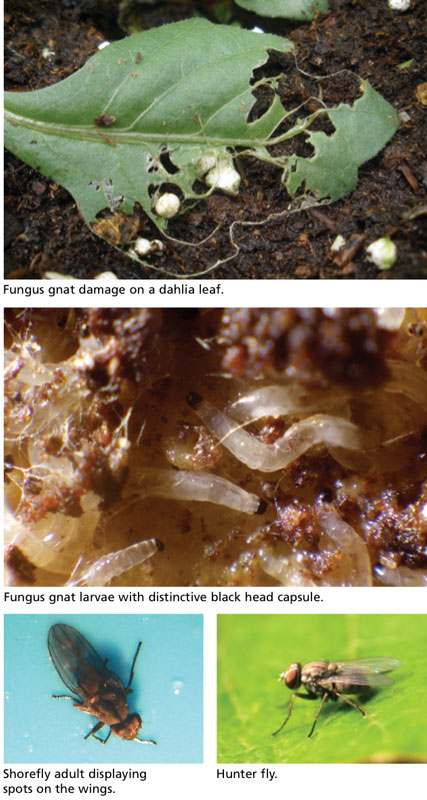12/1/2018
More Than a Nuisance
Rick Yates

There’s no debating it: Fungus gnats and shoreflies are a nuisance. They make insect-leery customers uncomfortable and they leave their calling cards (fecal matter) on the foliage of otherwise beautiful plant material. More than one grower has inhaled these tiny flies while hard at work in the greenhouse. Yuck!
That's not where the list of offenses ends; fungus gnats are a major pest of greenhouse crops, but don’t often get the attention they deserve. Direct plant damage occurs as larvae feed on roots, in stems, and occasionally on foliage, especially leaves in contact with the growing media. For seedlings and cuttings in propagation, the damage is sometimes fatal. Equally problematic, adult fungus gnats and shoreflies are known to spread root and crown rot diseases in their travels.
Proper identification of fungus gnats and shoreflies is important for control; some differences in chemical and biological control options need to be accounted for.
Adult fungus gnats are dark, delicate-looking flies, similar in appearance to mosquitoes, with slender legs and long, segmented antennae. Their wings are clear with a distinctive Y-shaped vein. Fungus gnat larvae have shiny black heads and elongated, whitish-to-clear, legless bodies.
Shorefly adults more closely resemble miniature houseflies. Compared to fungus gnats, shoreflies are stronger fliers with shorter legs and antennae. Shoreflies have five distinctive clear-to-white spots on their wings. Shorefly larvae are also clear-to-white, but lack a distinct head capsule. The pupal stage is dark brown and has an interesting “fork” structure on one end. While shorefly adults are able to spread plant pathogens, the larvae aren’t directly damaging to plants.
Habitat management
Habitat modification and good sanitation practices are the first lines of defense against fungus gnats and shoreflies. Fungus gnats lay their eggs in cracks and crevices in the soil media. In greenhouses, this most often occurs on the surface of the soil, but can also occur in drain holes in the sides and bottom of pots. Constantly moist soil media, and the algae it encourages, make a suitable habitat for fungus gnat larvae. Shore-flies live in consistently damp areas with abundant algae. The larval stage feeds on algae and the pupal stage is semi-aquatic, partially submerged in water.
Moisture management, including improved drainage and taking steps to limit algae, can pay dividends in terms of creating a less-favorable habitat for pest development. Power washing and use of approved cleaners, such as Strip-it Pro, can be used to remove organic matter from surfaces between crops. After a thorough cleaning, sanitation products such as Greenshield II, Kleengrow, SaniDate 5.0 and Zerotol 2.0 can be used to finish the job and ensure a clean start.
Control options
Chemical control of fungus gnats and shoreflies should target the larval stage because the control of the adults isn’t very effective with the available pesticides. (Table 1 details several product options. Note that all treatments are made to the soil.)
 Biological control often begins with soil treatments with nematodes, which are highly successful in controlling the larval stages of fungus gnats and shoreflies. S. feltiae is used for fungus gnats and S. carpocapsae for shoreflies. Nematode treatments are generally effective for about three weeks and can be applied to all types of crops and most types of growing media. Following treatment, the number of adults will decline gradually, as the adults die off and fewer emerge from the soil to replace them.
Biological control often begins with soil treatments with nematodes, which are highly successful in controlling the larval stages of fungus gnats and shoreflies. S. feltiae is used for fungus gnats and S. carpocapsae for shoreflies. Nematode treatments are generally effective for about three weeks and can be applied to all types of crops and most types of growing media. Following treatment, the number of adults will decline gradually, as the adults die off and fewer emerge from the soil to replace them.
Dalotia coriaria (aka Atheta or rove beetle) is a small beetle with a huge appetite for many soil-dwelling pests, including fungus gnat and shorefly larvae, with the thrips pupae control as an added bonus. Once established in a cool, moist location, they’ll often establish themselves in the crops. Stratiolaelaps scimitus, formerly known as Hypoaspis miles, is a tiny predator mite that patrols the soil surface and feeds on many of the same soil-dwelling pests that Dalotia does.
In greenhouses where pesticides are seldom used, the aptly named Hunter fly (Coenosia attenuate) will sometimes appear as a welcome ally. Hunter flies consume adult fungus gnats and shoreflies, along will some other flying insects. They’re not commercially available at this time, but they’ve been introducing themselves to commercial greenhouses in the northeastern U.S.
Use yellow sticky cards to monitor for adult fungus gnats and shoreflies, and deploy the BCAs at the first sign of pest pressure. Certain compatible pesticides can be safely used in conjunction with biological control agents. Contact your supplier for details and assistance.
Of course, always read and follow all label directions. The label is the law! Products other than those mentioned may be safe and effective. Some pesticides may be restricted use or unregistered in certain states. GT
Rick Yates is GGSPro Technical Support Manager for Griffin. He can be reached at ggsprotech@griffinmail.com.